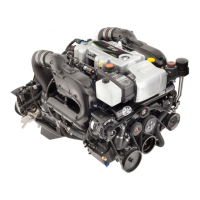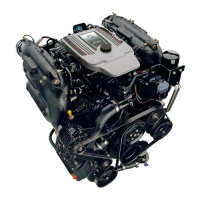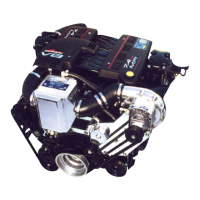Section 4 - Maintenance
Page 42 90-8M0113925 eng DECEMBER 2015
In either case, the ECM could shut off. When the voltage returns to the range that the ECM requires, the ECM will reset itself,
and the engine will operate normally. The ECM shuts off and resets itself so quickly that the engine may only seem to have an
ignition miss.
Batteries: Boats with multiengine EFI power packages require each engine be connected to its own battery. This ensures that
the engine's ECM has a stable voltage source.
Battery switches: Battery switches should always be positioned so each engine is operating off of its own battery. Do not
operate engines with switches in both or all position. In an emergency, another engine's battery can be used to start an engine
with a dead battery.
Battery isolators: Isolators can be used to charge an auxiliary battery used for powering accessories in the boat. They should
not be used to charge the battery of another engine in the boat unless the type of isolator is specifically designed for this
purpose.
Generators: The generator's battery should be considered another engine's battery.
Cleaning the Flame Arrestor
!
WARNING
Fuel is flammable and explosive. Ensure that the key switch is off and the lanyard is positioned so that the engine cannot
start. Do not smoke or allow sources of spark or open flame in the area while servicing. Keep the work area well ventilated
and avoid prolonged exposure to vapors. Always check for leaks before attempting to start the engine, and wipe up any
spilled fuel immediately.
1. Gently lift the top back edge of the silencer and pull forward to remove.
a - Silencer
b - Flame arrestor
2. Loosen the flame arrestor clamp and remove the flame arrestor.
a - Flame arrestor
b - Flame arrestor clamp
3. Clean the flame arrestor with solvent and dry with compressed air or set aside and allow to air dry completely.
4. Install the flame arrestor and tighten the clamp to the specified torque.

